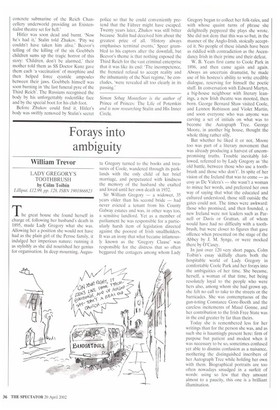Forays into ambiguity
William Trevor
LADY GREGORY'S TOOTHBRUSH by Co1m Toibin Lilliput, £12.99, pp. 128, ISBN 1901866823 The great house she found herself in charge of, following her husband's death in 1895, made Lady Gregory what she was. Allowing her a position she would not have had as the plain girl of the Persse family. it indulged her imperious nature: running it as stylishly as she did nourished her genius for organisation. In deep mourning, Augus
ta Gregory turned to the books and treasures of Coole. wandered through its parklands with the only child of her brief marriage, and perpetuated with kindness the memory of the husband she exalted and loved until her own death in 1932.
Sir William Gregory — a widower, 35 years older than his second bride — had never evicted a tenant from his County Galway estates and was, in other ways too, a sensitive landlord. Yet as a member of parliament he was responsible for a particularly harsh item of legislation directed against the poorest of Irish smallholders. It was an irony that what became infamously known as the 'Gregory Clause' was responsible for the distress that so often beggared the cottagers among whom Lady Gregory began to collect her folk-tales, and with whose quaint turns of phrase she delightedly peppered the plays she wrote. She did not deny that this was so but, in the manner of the Anglo-Irish, stoically accepted it. No people of these islands have been as riddled with contradiction as the Ascendancy Irish in their prime and their defeat.
W. B. Yeats first came to Coole Park in 1896, and then came again and again. Always an uncertain dramatist, he made use of his hostess's ability to write credible dialogue, reserving for himself the poetic stuff. In conversation with Edward Martyn, a big-house neighbour with literary leanings, a new Irish theatre was mooted, then born. George Bernard Shaw visited Coole, and Lennox Robinson and Violet Martin, and soon everyone who was anyone was carving a set of initials on what was to become the Autograph Tree. George Moore, in another big house, thought the whole thing rather silly.
But whether he liked it or not, Moore too was part of a literary movement that was already producing a harvest of uncompromising truths. Trouble inevitably followed, referred to by Lady Gregory as 'the old battle, between those who use a toothbrush and those who don't'. In spite of her vision of the Ireland that was to come — as cosy as De Valera's — she wasn't a woman to mince her words, and preferred her own way of saying that what the educated and cultured understood, those still outside the gates could not. The times were awkward: those who promised, and then founded, a new Ireland were not leaders such as Parnell or Davis or Grattan, all of whom would have had no difficulty with a toothbrush, but were closer to figures that gave offence when presented on the stage of the Abbey by J. M. Synge, or were mocked there by O'Casey.
In just over 120 very short pages, Co1m Toibin's essay skilfully charts both the hospitable world of Lady Gregory in comfortable Coole Park and her forays into the ambiguities of her time. She became, herself, a woman of that time, but being resolutely loyal to the people who were hers also, among whom she had grown up, she felt no call to take to the streets or the barricades. She was contemptuous of the gun-toting Constance Gore-Booth and the careless incitements of Maud Gonne, and her contribution to the Irish Free State was in the end greater by far than theirs.
Today she is remembered less for her writings than for the person she was, and as such she is hauntingly present here: firm of purpose but patient and modest when it was necessary to be so, sometimes confused yet able to dismiss confusion as a nuisance, mothering the distinguished inscribers of her Autograph Tree while holding her own with them. Biographical portraits are too often nowadays smudged in a surfeit of words: using so few that they amount almost to a paucity, this one is a brilliant illumination.






































































 Previous page
Previous page